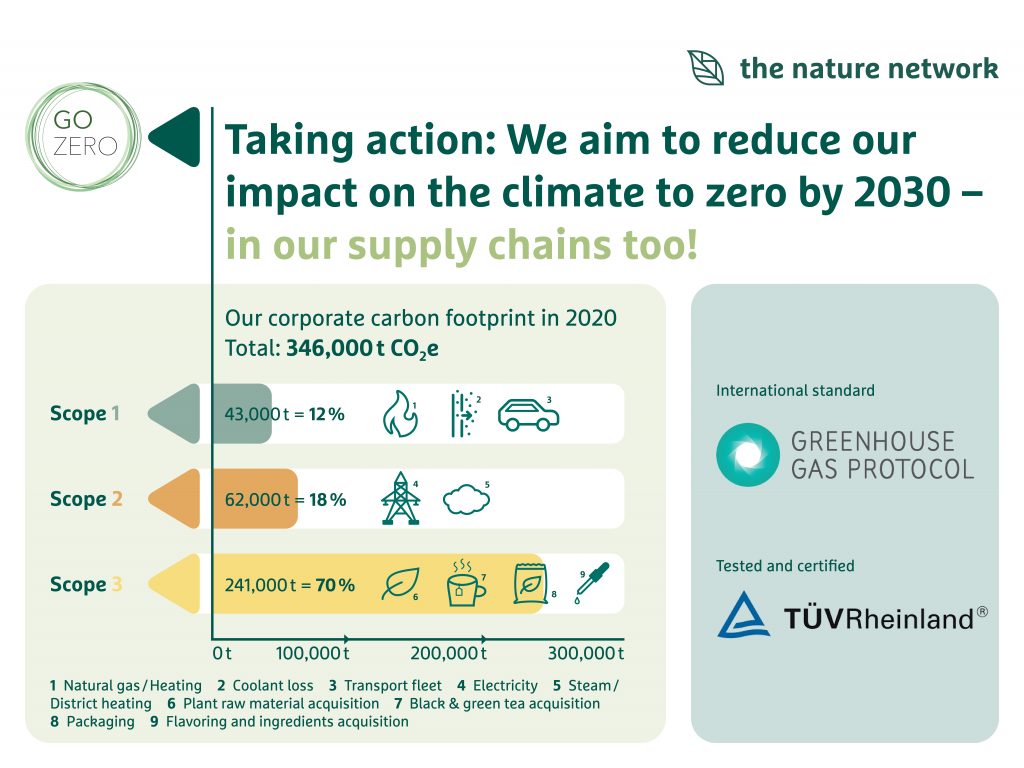Plausible, transparent, complete
MartinBauer and all other members of global group of companies the nature network are taking responsibility for the CO2 emissions produced by their business operations. For the first time in its history, the group has calculated its corporate carbon footprint, which has now been checked and certified by an independent external body.
Committed to climate neutrality
The group’s goal is clear: to make its business operations climate-neutral by 2030. This commitment includes all greenhouse gas emissions from the group’s more than 30 sites worldwide and within its global supply chains. The nature network is striving to prevent emissions where possible, to continuously reduce them, and to compensate only for those that cannot be avoided.
According to international standards
With this goal already in sight, the nature network set out to precisely calculate its greenhouse gas emissions for the very first time. The final calculation was made in accordance with the international standards of the Greenhouse Gas (GHG) Protocol. The calculation includes the seven major greenhouse gases defined by the Intergovernmental Panel on Climate Change (IPCC) and identified in the Kyoto Protocol. The nature network’s corporate carbon footprint not only includes the emissions that the group is directly responsible for (Scopes 1 and 2 of the GHG Protocol) but also the emissions of upstream supply chains (Scope 3). This way, the nature network is being completely transparent about all its business activities that have a significant impact on the climate.
Tested by TÜV
Certification body TÜV Rheinland has checked that the data provided in the carbon footprint are plausible and complete and that the footprint adheres to the GHG Protocol. At the end of the process, certification was awarded. Norbert Heidelmann, Department Manager for Sustainability and Carbon Services at TÜV Rheinland Energy GmbH was happy to confirm the nature network’s high standards and the pioneering role it has played: “Although this was its first carbon footprint calculation, the nature network’s data collection was exemplary – particularly for its upstream supply chains. Creating transparency in supply chains is especially important, but it is also very challenging for companies because of the vast amounts of data involved and the difficulties in acquiring them. Working out the CO2 emissions involved in the acquisition of plant raw materials, as the nature network has done, helps other companies in the sector that are serious about collecting data on the CO2 emissions in their own supply chains and about reducing those emissions.”
Findings
In 2020 the nature network’s carbon footprint was 346,000 tonnes of CO2 equivalents (CO2e). That’s around the same as the annual CO2 emissions of a small European town with 31,500 inhabitants.
Around 70 percent of those emissions came from upstream business processes covered in Scope 3 – i.e. processes that the nature network has only limited direct impact on. By far the greatest share of emissions (55 percent) comes from the acquisition of plant raw materials, flavorings and ingredients. In second place, with 21 percent, is heating for extract production, and in third (12 percent) electricity consumption for production facilities and company premises.

Inspired to achieve more
“The findings of our carbon footprint combined with our ambitious climate goal have motivated us to address the challenges of climate change mitigation in a targeted and effective way,” says Sebastian Sieben, CEO of MartinBauer Europe. “As we proceed along the path to climate neutrality we are constantly learning and evolving. We hope to take our customers along with us on our journey and inspire our market partners so that we have as broad an impact as possible.”
Where to take action?
The most effective way to reduce CO2 emissions at sites around the world is to conserve energy and to make greater use of renewable energy sources. That isn’t just an environmental consideration, it’s an economic one too. The greatest potential for saving energy in the nature network’s global supply chains is in the drying of plant materials, particularly when it isn’t possible to use the heat of the sun. But we should also be directing our attention at more climate-friendly field management and cultivation methods. Possible measures range from targeted crop rotation systems, digging plant remains into the soil, optimized fertilizer use, and the planting of hedges and shade trees. The effectiveness of all these measures will be checked regularly, as the company will be calculating its carbon footprint annually from now on.
Close cooperation in the supply chains
The nature network is closely involving its suppliers in its goal to become climate-neutral. Some of our raw materials partners played a direct role in the data-gathering process, using an online calculator to provide information about the area of land they cultivate, for example, and their use of diesel and fertilizer. This didn’t just make the data more reliable; the evaluation also gave raw materials partners tips for reducing their own CO2 emissions. The nature network is helping its supply chain partners make their processes more climate-friendly by providing its specialist knowledge and experience.